I am named after no one in particular. I know because I asked. I asked because I have always hated my name and wondered why of all the names out there Cheryl was chosen for me. My parents and their families are Polish. Our roots in this country are barely established. They are also strongly Catholic, again a very defining affiliation, so I guess I would have expected I would have a Polish, or at least a Biblical name. Not so much.
Names fascinate me, because at least up until recently ( in most cases other than my own,) a name usually told a story, or at least some small part of one. They connect you to a history, a culture, a family. My brother in law was telling me about a friend of theirs who, while in the maternity ward with their youngest, was taking record of the other baby names and could not help but be horrified to see this name on a bassinet…..La-ah. To the uninitiated, that would be pronounced lahdashah, but the letters in “dash” are represented by the symbol – .
It makes me sad to think how disconnected this child will always be. Made up names, especially ones that are so beyond normal rules of pronunciation and comprehension , do not ground you to anything. They say nothing endearing about who you are or where you came from, and that is always how I felt about mine. Cheryl was not a popular movie star name, had no clear affiliation with a race of people or country of origin, no great story of why that name belongs to me exists. To boot, I have never had a nickname, or a cute abbreviation, leaving me only the one icky and unconnected name.
Somehow, conversely, that has translated to me always being very curious about names, which has naturally led to an obsession with plants names and the consequent study of them in both their common and botanical Latin form .
The plant I am talking about today has more names than any one thing should have. It has common names referencing a country, someones offspring, , a bird, several other plants, and even a weapon.
It has been botanically named and renamed until i am no longer sure what is the correct and current one to use.
to whit….it is a member of the Iris family ( iridacea) yet called variously an orchid and a lily.
It It is a gladiolus, yet has born the name acidanthera
It has been known in botanical Latin as Gladiolus callianthus ( beautifully flowered)
Gladioulus murielae ( after botanist Ernest Wilson’s daughter Muriel)
Acidanthera bicolor ( obvious when you see it bloom)
Acidanthera murielae
and commonly as Abyssinian gladiolus ( from Ethiopia)
Peacock orchid
Fragrant gladiolus and
Sword lily
Yikes. Anyway, just pick one and call it that . I will stick to Peacock Orchid for now, because I am sensitive to yucky names, and personally like that one. Peacock orchids, unlike other gladiolus are graceful . They nod instead of standing ramrod straight and are anything but funereal. They are planted out as little corms, here (Z5) in late spring after frost or even a little before, and by midsummer have grown to 2-3 ft and start blooming. The flowers are a creamy white with a maroon center, and mildly fragrant. 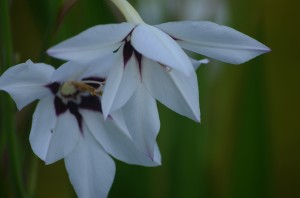 .
.
There are many great reasons to love this plant. First..it is dirt cheap. you can get the corms anywhere and plant them in the ground or in pots. They are only hardy to zone 7, but in colder areas if you lift them at the end of the season and store them in perlite over the winter in your house, you can plant the old bulbs as well as all of the offsets they produced next year, This translates to $$$ saved on annuals .As someone who gardens on an acre and plants as many as 50 containers a year, cost matters. I warmer areas they will multiply if left in the ground.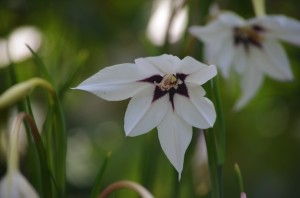 .
.
Secondly, you can easily stagger the bloom time by planting the corms in waves , and if you do this in pots, will have many plants to place in any area that needs a pick me up when the long summer takes it’s toll on the garden. You can move the growing plants from the pot into the ground , drop the pots into more decorative pots, or place them pots and all in the ground. Your choice, all will work.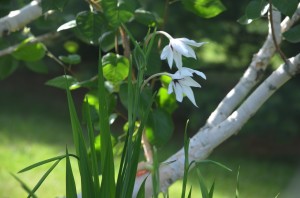
Third, they are easy. They are full sun plants, but will tolerate part shade and so far they have suffered no pest damage here. I have them growing in the ground and in 3 different containers and they all look beautiful. In one container I have a black eyed susan vine working its way up their stalks and into the tree above them, which was a brilliant idea if I do say so myself.
Peacock orchids combine very well with other containers plants both when it has just its dramatic foliage as well as when it is is bloom because the color is subtle.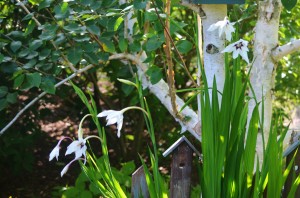
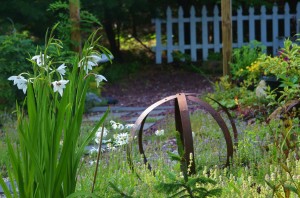
Whatever you call it, be sure add it to your “need to plant” list next spring